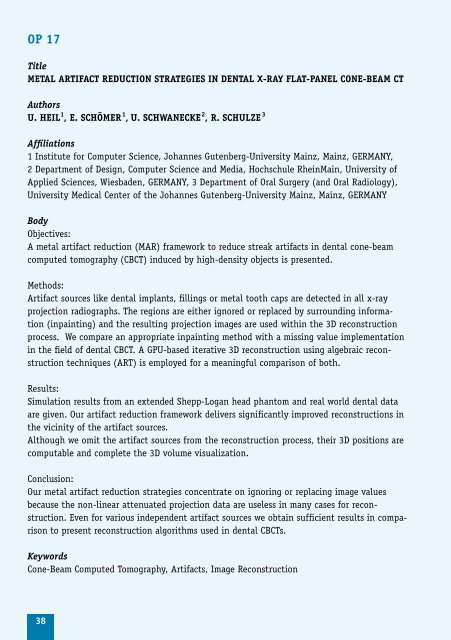Program including abstracts as pdf available here
Program including abstracts as pdf available here
Program including abstracts as pdf available here
Create successful ePaper yourself
Turn your PDF publications into a flip-book with our unique Google optimized e-Paper software.
OP 17<br />
Title<br />
METAL ARTIFACT REDuCTION STRATEGIES IN DENTAL X-RAy FLAT-PANEL CONE-bEAM CT<br />
Authors<br />
u. HEIL 1 , E. SCHÖMER 1 , u. SCHWANECKE 2 , R. SCHuLzE 3<br />
Affiliations<br />
1 Institute for Computer Science, Johannes Gutenberg-University Mainz, Mainz, GERMANY,<br />
2 Department of Design, Computer Science and Media, Hochschule RheinMain, University of<br />
Applied Sciences, Wiesbaden, GERMANY, 3 Department of Oral Surgery (and Oral Radiology),<br />
University Medical Center of the Johannes Gutenberg-University Mainz, Mainz, GERMANY<br />
Body<br />
Objectives:<br />
A metal artifact reduction (MAR) framework to reduce streak artifacts in dental cone-beam<br />
computed tomography (CBCT) induced by high-density objects is presented.<br />
Methods:<br />
Artifact sources like dental implants, fillings or metal tooth caps are detected in all x-ray<br />
projection radiographs. The regions are either ignored or replaced by surrounding information<br />
(inpainting) and the resulting projection images are used within the 3D reconstruction<br />
process. We compare an appropriate inpainting method with a missing value implementation<br />
in the field of dental CBCT. A GPU-b<strong>as</strong>ed iterative 3D reconstruction using algebraic reconstruction<br />
techniques (ART) is employed for a meaningful comparison of both.<br />
Results:<br />
Simulation results from an extended Shepp-Logan head phantom and real world dental data<br />
are given. Our artifact reduction framework delivers significantly improved reconstructions in<br />
the vicinity of the artifact sources.<br />
Although we omit the artifact sources from the reconstruction process, their 3D positions are<br />
computable and complete the 3D volume visualization.<br />
Conclusion:<br />
Our metal artifact reduction strategies concentrate on ignoring or replacing image values<br />
because the non-linear attenuated projection data are useless in many c<strong>as</strong>es for reconstruction.<br />
Even for various independent artifact sources we obtain sufficient results in comparison<br />
to present reconstruction algorithms used in dental CBCTs.<br />
Keywords<br />
Cone-Beam Computed Tomography, Artifacts, Image Reconstruction<br />
38


